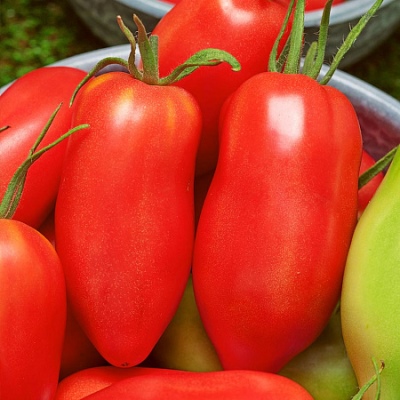
- Name synonyms: Hugo, Hugo
- Category: grade
- Growth type: indeterminate
- Appointment: universal
- Ripening period: mid-season
- Ripening time, days: 105-115
- Growing conditions: for open ground, for film greenhouses, for greenhouses
- Marketability: high
- Transportability: good
- Bush height, cm: 60-80
The foreign name of a plant does not mean that it is worse or better than the domestic one in itself. The more relevant is a careful study of the characteristics of each culture. It allows you to prepare for garden work as adequately as possible.
Description of the variety
The Hugo tomato has 2 officially used synonyms - Hugo and Hugo. This variety is characterized by indeterminate development. It is believed to be versatile in its scope. The culture is declared to be suitable for all major horticultural regions of Russia. The bushes are not high, they can reach a maximum of 0.6-0.8 m.
The main qualities of the fruit
Hugo's large ripe berries have a pleasant red hue. Their average weight is 200 g. Pepper-shaped configuration is typical for these tomatoes. The fruit is covered with a smooth peel. Putting the crop in a relatively cool place, not exposed to moisture, you can save it for 4-5 months.
Taste characteristics
Hugo's firm flesh leaves a pleasant impression. It is invariably meaty, which also enhances the effect. There are almost no seeds in the fruits and do not have any significant effect on taste.
Ripening and fruiting
The Hugo tomato is usually classified as a mid-season. It is usually possible to get ripe berries in 105-115 days after sprouting. Harvested in July, August, under favorable conditions - in September.
Yield
The official description does not describe the collection amount. According to third-party sources, it can reach 12 kg per 1 sq. m. Of course, the weather specifics makes its own adjustments.
The timing of planting seedlings and planting in the ground
It is necessary to sow containers with prepared substrate in the first decade of March. If everything is done correctly, usually the readiness for disembarkation is achieved in the first days of May. It is imperative to take into account the readiness of specific seedlings.

Growing tomato seedlings is an extremely important process, because it largely depends on whether the gardener can harvest at all. All aspects must be taken into account, from seedbed preparation to planting in the ground.
Landing scheme
The official description insists on a 400x600mm planting system. There is no reason to doubt this result.

Growing and caring
Tying a tomato to a support and giving it a certain shape is necessary in any case. They cultivate 1-2 stems. Experts emphasize the need to disinfect not only seeds and soil, but also containers used for seedlings. Optimal self-prepared soil includes:
35% peat;
1/5 high quality branded primer;
30% garden soil not previously used by tomatoes;
1/10 vermicompost;
1% vermiculite and 4% perlite.
The optimal drainage layer is charcoal in the form of a fine fraction. 5-7 cm of the main batch of soil is poured onto it. When irrigating, not just water is used, but a solution of potassium humate mixed with trace elements. Containers with seedlings are kept under a film at a temperature of 28-30 degrees. When shoots appear, they wait 4-7 days, remove the film and withstand planting from 3 to 5 days with round-the-clock illumination.
Before picking, a soil mixture is prepared, improved by the addition of borofoski. The seedling must be dived into the watered soil. The next watering is allowed to be done only after 5 days. Hardening seedlings involves reducing the temperature to 13-15 degrees for several hours every day. So that the soil at the final chosen place is ready, mineral fertilizers are laid in it.
Hugo's landing is best timed to coincide with a cloudy day. In the last 2-3 days before transferring to open ground or a greenhouse, the plants are not watered for 48 to 72 hours. It is advisable to combine the first watering with fertilizing with ammonium sulfate and nitrogen. The hotter the weather is, the more of this solution should be used.




A plant needs different micronutrients at each stage of growth. All fertilizers can be divided into two groups: mineral and organic. Folk remedies are often used: iodine, yeast, bird droppings, eggshells.
It is important to observe the rate and period of feeding. This also applies to folk remedies and organic fertilizers.


Resistant to adverse weather conditions
This plant cannot boast of special resistance to cold weather. On the contrary, even relatively weak frosts can damage it. It is necessary to cover the culture, until the onset of steadily warm days. It is necessary to pay attention to the danger of frost directly on the soil.

























































































